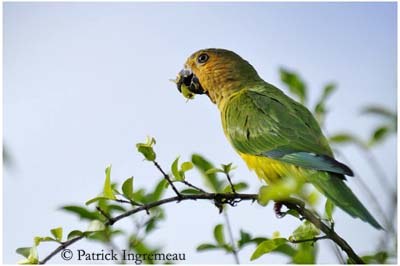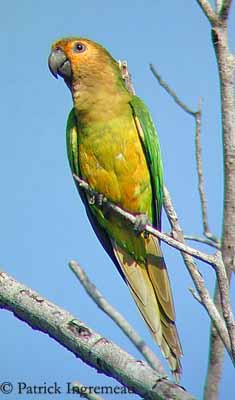
Brown-throated Parakeet
Eupsittula pertinax
Psittaciforme Order – Psittacidae Family
BIOMETRICS:
Length: 25 cm
Weight: 76-102 g
LONGEVITY: Up to 10 years in wild (Up to 25 years in captivity)
DESCRIPTION:
Brown-throated Parakeet is native to northern Colombia and northern Venezuela. It can live up to 25 years in captivity.
Brown-throated Parakeet has green upperparts with bluish-green flight feathers.
Underparts are paler. Throat and upper breast are pale olive-green. Lower breast is rather greenish-yellow, with orange tinge on belly.
Underwings show greenish-yellow coverts. The underside of flight feathers is dark grey. Undertail is olive-yellow.
On the head, it has brown to greyish-brown forehead, sides of head and upper breast. Crown is green, washed bluish on top. Bill is dusky, almost blackish. Eyes are yellow, with bare olive eye-ring, and yellow feathers around the eyes.
Immature has brown cheeks, and upper mandible is horn-coloured. It has greenish throat and upper breast, instead pale olive-brown.
PROTECTION / THREATS / STATUS:
Brown-throated Parakeet has large range. Populations seem to be increasing, and this species is described as “common”.
Brown-throated Parakeets damage grain crops when they feed in large numbers.
Fr: Conure cuivrée
All : Braunwangensittich
Esp : Aratinga Pertinaz
Ital : Conuro golabruna
Nd : Maïsparkiet
Photos de Patrick Ingremeau
TAMANDUA
Texte de Nicole Bouglouan
Sources :
HANDBOOK OF THE BIRDS OF THE WORLD vol 4 by Josep del Hoyo-Andrew Elliott-Jordi Sargatal - Lynx Edicions - ISBN: 8487334229
PARROTS OF THE WORLD – An Identification Guide – by Joseph M. Forshaw – Princeton University Press – ISBN 0691092516
A GUIDE TO THE BIRDS OF COLOMBIA by Steven L. Hilty and William L. Brown
Princeton University Press – ISBN 069108372X
Arthur Grosset's Birds (Arthur Grosset)

We can find 14 subspecies, with different extend and intensity of yellow on head, and brown on throat and upper breast.
A.p. pertinax ; A.p. xanthogenia ; A.p. arubensis; A.p. aeruginosa ; A.p.griseipecta ; A.p. lehmanni ; A.p. tortugensis ; A.p. margaritensis ; A.p. venezuelae ; A.p. chrysophrys ; A.p. surinama. A.p. chrysogenys; A.p. paraensis; A.p. ocularis.
VOICE: SOUNDS BY XENO-CANTO
Brown-throated Parakeet in flight, utters high-pitched shrill calls often repeated “crik-crik-…crak-crak”. When bird is perched, we can hear “cheer-cheeedit”, with second note prolonged before ending abruptly. It also utters chattering when at rest.
This species is noisy, calling in flight, and often heard before seen. Brown-throated Parakeet often calls from perch or top of bare branch of dead tree, uttering loud calls.
During the day, they usually travel in pairs or small groups, and feed together. While flock is feeding, some birds are watching for danger, and alert the rest of the group if a predator is detected.
Brown-throated Parakeet, as other parakeets, enjoys tearing the bark off the branches, and they often damage trees when they are in great numbers.
FLIGHT:
Brown-throated Parakeet flies fast and low. They form tight twisting flocks, performing erratic twisting or turning, relatively low to the ground. These acrobatic, noisy flights occur before settlement at night-roost.
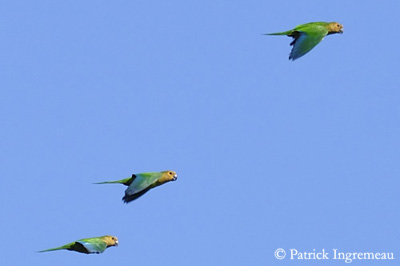
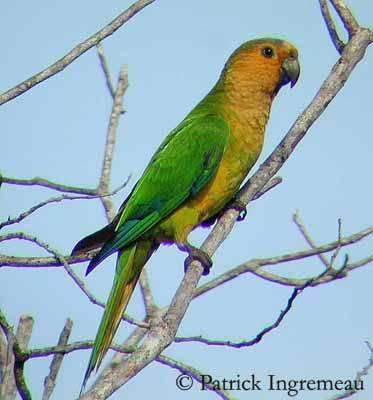
HABITAT:
Brown-throated Parakeet lives in open, wooded countries, natural savannahs, arid scrubs, mangroves, cultivated areas with scattered trees, urban parks and gardens. It may be found up to 1,000 metres of elevation.
RANGE:
Brown-throated Parakeet is found in extreme eastern Costa Rica to Central Panama, in northern South America (north of Amazon River), and islands off north coast of Venezuela.
This species has been introduced to St. Thomas and nearby Saba, in Virgin Islands, West Indies.
BEHAVIOUR:
Brown-throated Parakeet is usually seen in pairs or small groups, but they may be very numerous at communal roost or around concentrated food resources.
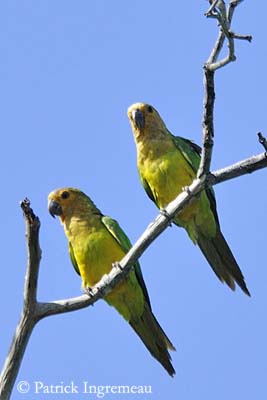
REPRODUCTION:
Breeding season usually occurs between February and September. Brown-throated Parakeet nests in cavity in tree, or in nest-box in captivity.
Female lays 3 to 6 eggs, usually on the bare base of the nest, without vegetal lining, except sometimes bark chips. Incubation lasts about 23 days. Young fledge 50 days after hatching. They sometimes remain with their parents and form small family groups. When young fledge, male still feeds them, while female prepares next clutch.
This species produces several broods per year.
DIET:
Brown-throated Parakeet feeds on fruits, flowers and seeds of several plants.
